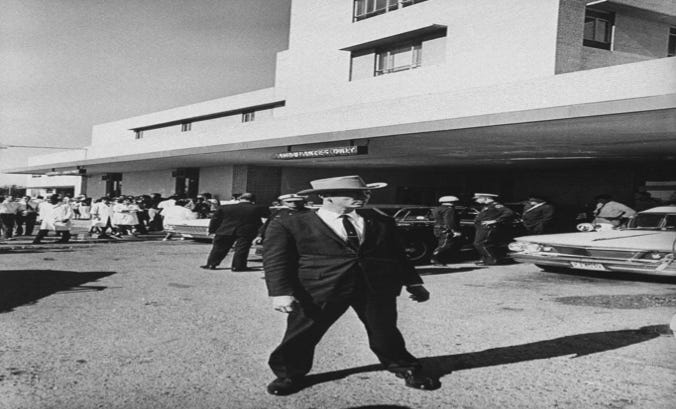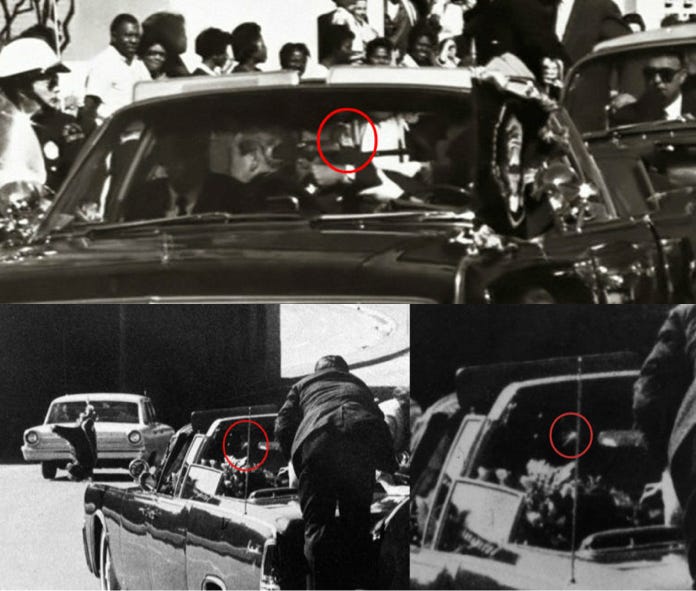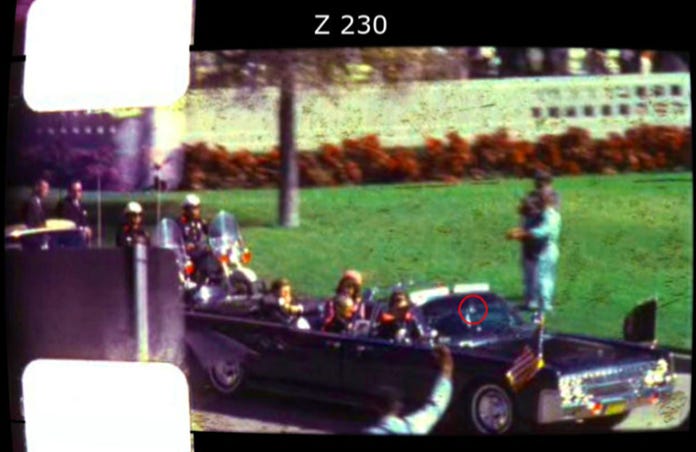Thomas Lipscomb: Hidden In Plain Sight The Key To The Kennedy Assassination Is On Public Display In The National Archives Emerald Robinson
NOTE: The renowned journalist Thomas Lipscomb has just completed a new manuscript (with Jerome Kroth) titled The Oswald Letter and it contains a number of staggering claims based on these federally released documents as well as fresh accounts from new eyewitnesses who have never before been interviewed. This is the third excerpt from The Oswald Letter to appear here on my Substack.
According to the catalog listing of the National Archives in Washington, this is the “Windshield Removed from the Presidential Limousine that Carried President John F. Kennedy During the Assassination.” It is still carrying its FBI evidence tab.
But is it?
The Secret Service had the Presidential limousine shipped from Dallas to the White House garage the night of the assassination. Then they sent it to the Ford Factory at River Rouge in Detroit, where it was built, for refitting.
When a senior manager there, George S. Whitaker, came to work two days after the assassination, he was ordered to immediately report to the glass plant lab. He was let in through locked doors and found two of his men had already removed the limousine windshield.
As Whitaker said in a recorded interview: “And the windshield had a bullet hole in it, coming from the outside through…it was a good, clean bullet hole, right straight through, from the front. And you can tell, when the bullet hits the windshield, like when you hit a rock or something, what happens? The back chips out and the front may just have a pinhole in it…this had a clean round hole in the front and fragmentation coming out the back.”
In an interview a few months later he added: “The hole was about 4 or 6 inches to the right of the rear view mirror [as viewed from the front]. The impact had come from the front of the windshield. If you have spent 40 years in the glass [illegible] you know which way the impact was from.”
Following their orders, Whitaker had his men use the old windshield as a template, create and install a new one, and then once again following orders, they ground up and destroyed the original windshield with the bullet hole in it. The refurbished limousine was then sent back to the Secret Service in Washington.
Whitaker is far from the only witness who saw a bullet hole in the windshield. Several members of the Dallas Police, a nurse, and several doctors (and others) at Parkland Hospital noticed it when it was still parked outside while doctors were trying to save Kennedy. One motorcycle patrolman was quite specific: “There was a hole in the left front windshield…It was a hole, you could put a pencil through it…you could take a regular standard writing pencil…and stick [it] through there.”
Dallas Motorcycle Patrolman inspecting limo windshield at Parkland
None were called as witnesses by the Warren Commission.
The Warren Commission finding? “The windshield was not penetrated by any bullet. A small residue of lead was found on the inside surface of the windshield; on the outside of the windshield was a very small pattern of cracks immediately in front of the lead residue on the inside. The bullet from which this lead residue came was probably one of those that struck the President and therefore came from overhead and to the rear. Experts established that the abrasion in the windshield came from impact on the inside of the glass.”
To make this clear, the windshield in the photo (on display at the National Archives today) has a small black circle on the left side. Blown up by the National Archives, the area looks like this:
It certainly doesn’t look at all like Whitaker’s bullet hole. Or what a young medical student at Parkland described. She said: “No way there’s even any cracks associated with that bullet hole, It seemed like a high velocity bullet that had penetrated from front to back in that glass pane” A St. Louis Post Dispatch reporter saw it and said: ““A few of us noted the hole in the windshield when the limousine was standing at the emergency entrance after the President had been carried inside.”
Even a Secret Service agent reported to his boss after inspecting the limousine in the White House Garage, after it had been flown back from Dallas on the day of the assassination: “In addition, of particular note was the small hole just left of center in the windshield from which what appeared to be bullet fragments were removed.”
Most tellingly, some of the first photos taken during the assassination by professionals like Ike Altgens of the Associated Press and even amateurs like Muchmore have this common disfigurement on the same place on the windshield that doesn’t look at all like the cracks on the windshield in the National Archive. In fact they look more like — a bullet hole.
Here are two of Altgens’ photos taken about a second and a half after the first bullet hit President Kennedy. Notice the circle.
All factions to the never-ending argument about who killed Kennedy agree that the first shot hit the President as his limousine passed behind a Stemmons Freeway sign, which temporarily obscured it from the Zapruder film.
But in Zapruder frame 230, the limo emerges with Kennedy clutching his throat from the effects of the first shot. He’s been hit. The Warren Report details Oswald’s two hits for his three shots. All of them came from behind the limousine from Oswald’s “sniper’s nest” up on the 6th floor of the Dallas School Book Depository.
The first shot missed and nicked a bystander with a piece of the bullet or pavement. The first shot that hit Kennedy where he is clutching his throat, shown in frame 230, is the one the Commission claims was “the magic bullet.” This bullet, we were assured, entered Kennedy’s back, exited his throat and went into Governor John Connelly’s back then down his arm, shattering his wrist, and ended up in his thigh. The final bullet fired was the fatal headshot.
But there in frame 230, in the Zapruder film as well as the Altgens, is that white spec on the left side of the windshield, in exactly the same place in all photos. It doesn’t take a ballistics genius to see, just looking at the Zapruder frame, that if one draws a straight line to the place Kennedy is clutching his throat to the white spec on the windshield — and it IS a bullet hole, just as so many witnesses have said, the line of fire extends to the FRONT of the limousine. And that means the first shot to hit Kennedy came from in front of him.
And in that one discovery it becomes clear why the windshield with the bullet hole was destroyed, why the witnesses were disregarded, and why the phony windshield was put on exhibit in the Archives. The Federal Government was destroying evidence that would impeach the findings it wanted produced and faking the evidence it wanted seen. It claimed only two bullets hit Kennedy, both from the rear from Oswald on the 6th floor. But if the first bullet came from the front, what about the second bullet? And Whitaker was ordered to destroy the windshield on the day of Kennedy’s funeral. The Warren Commission hadn’t even been created yet.
Ten years ago a privately printed book came out by a remarkable Certified Senior Crime Scene Analyst named Sherry Feister. She had been working in crime scene investigation and crime scene reconstruction for 30 years. The Federal Government could destroy the original windshield with the bullet hole, but it couldn’t destroy those photos and records of witnesses, and Feister knew just what to look for and what to do with them when she found them. She had done it all her life with many a crime scene.
For the first time the cold equations of forensic science were applied to the considerable evidence that still existed rather than the passions, speculations, and wild theorizing of well-meaning amateurs. It also meant after 50 years, time was running out for the Warren Commission’s carefully constructed façade of lies and misdirections. But the book received little publicity so its remarkable work never reached proper public notice.
After a deeply detailed consideration of the evidence and locations, Sherry Feister sited the source of the first shot from the front to trees along a Terminal Annex parking lot on the South Knoll to Kennedy’s left front headed down Elm Street. It was not the much-discussed “Grassy Knoll” to the right of the underpass. She concluded it was a perfect headshot at 150 yards deflected down by hitting the angled windshield into Kennedy’s throat below his Adam’s apple. The sniper knew his business.
With the Kennedy limo headed right towards his location, improving his odds considerably, the assassin lined up the fatal head shot from almost the same position at a range of only 100 yards. And he fired and vanished from his position among dozens of parked cars. His work was done.
At a press conference for the doctors who tried to save Kennedy at Parkland, an hour after he was declared dead, Dr. Malcolm Perry stated clearly the wound in Kennedy’s throat was an entrance wound and the bullet appeared to be coming from in front of him. Dr. Perry had not only seen the original wound, he installed the tracheal bypass that distorted it in later photos.
Later Dr. Perry (like so many other witnesses including Kennedy intimates David Powers and Kenneth O’Donnell who had claimed shots were fired in front of the limo) was intensely pressured by the Secret Service. He was called by doctors doing the autopsy that same night at Bethesda and Warren Commission staff to change his testimony. He finally stated it could be an entrance or an exit wound. That went into the Warren Report.
Members of the Warren Commission were pressured as well. Commissioners Richard Russell, Hale Boggs and John Sherman Cooper refused to sign the final Warren Report unless their objections to the ludicrous “magic bullet” theory were contained in the records of the Warren Report. President Johnson and Chief Justice Warren were personally contacted and well aware of this. And then the General Counsel J. Lee Rankin’s lie that their objections were included wasn’t exposed to them until Harold Weisberg told Russell’s chief of staff — years later.
The National Archives are a repository for the records of the government. They can hardly be blamed for exhibiting a fraud that they have been told is an historic object and cataloging it as it was described to them by those in authority.
But one might well ask why the government would also evade a 1992 Records Act passed by Congress, signed by a president requiring ALL documents pertaining to the Assassination to be released by 2017-2018, and deny full release under both Presidents Trump and Biden because of idiotic “security practices concerns”?
Perhaps because we now see the Federal Government had been destroying evidence, changing testimony, and intentionally lying to the American people for almost 60 years about the facts it knew well about the assassination of a beloved American president one November day in 1963.
In any case, as long as that phony windshield keeps being exhibited at the National Archive, there is a constant reminder that for all the Freedom of Information laws and pledges of transparency by political candidates, our current government not only wants to govern our present and arrange our future, but to control our understanding of the past as well.
Comments are closed.




